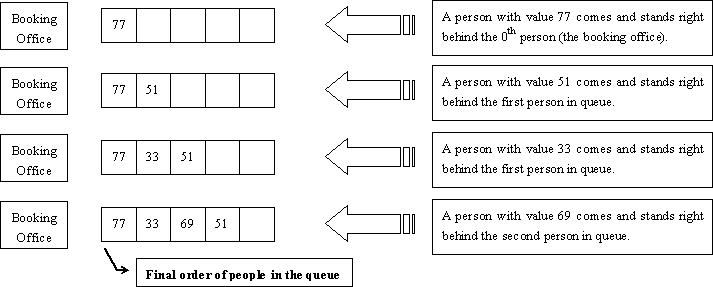POJ2828(插队问题)
2016-01-14 16:47
176 查看
Buy Tickets
Description
Railway tickets were difficult to buy around the Lunar New Year in China, so we must get up early and join a long queue…
The Lunar New Year was approaching, but unluckily the Little Cat still had schedules going here and there. Now, he had to travel by train to Mianyang, Sichuan Province for the winter camp selection of the national team of Olympiad in Informatics.
It was one o’clock a.m. and dark outside. Chill wind from the northwest did not scare off the people in the queue. The cold night gave the Little Cat a shiver. Why not find a problem to think about? That was none the less better than freezing to death!
People kept jumping the queue. Since it was too dark around, such moves would not be discovered even by the people adjacent to the queue-jumpers. “If every person in the queue is assigned an integral value and all the information about those who have jumped the queue and where they stand after queue-jumping is given, can I find out the final order of people in the queue?” Thought the Little Cat.
Input
There will be several test cases in the input. Each test case consists of N + 1 lines where N (1 ≤ N ≤ 200,000) is given in the first line of the test case. The next N lines contain the pairs of values Posi and Valiin the increasing order of i (1 ≤ i ≤ N). For each i, the ranges and meanings of Posi and Vali are as follows:
Posi ∈ [0, i − 1] — The i-th person came to the queue and stood right behind the Posi-th person in the queue. The booking office was considered the 0th person and the person at the front of the queue was considered the first person in the queue.
Vali ∈ [0, 32767] — The i-th person was assigned the value Vali.
There no blank lines between test cases. Proceed to the end of input.
Output
For each test cases, output a single line of space-separated integers which are the values of people in the order they stand in the queue.
Sample Input
Sample Output
Hint
The figure below shows how the Little Cat found out the final order of people in the queue described in the first test case of the sample input.

线段树处理。注意 0<=pos[i]<=i-1
| Time Limit: 4000MS | Memory Limit: 65536K | |
| Total Submissions: 17077 | Accepted: 8466 |
Railway tickets were difficult to buy around the Lunar New Year in China, so we must get up early and join a long queue…
The Lunar New Year was approaching, but unluckily the Little Cat still had schedules going here and there. Now, he had to travel by train to Mianyang, Sichuan Province for the winter camp selection of the national team of Olympiad in Informatics.
It was one o’clock a.m. and dark outside. Chill wind from the northwest did not scare off the people in the queue. The cold night gave the Little Cat a shiver. Why not find a problem to think about? That was none the less better than freezing to death!
People kept jumping the queue. Since it was too dark around, such moves would not be discovered even by the people adjacent to the queue-jumpers. “If every person in the queue is assigned an integral value and all the information about those who have jumped the queue and where they stand after queue-jumping is given, can I find out the final order of people in the queue?” Thought the Little Cat.
Input
There will be several test cases in the input. Each test case consists of N + 1 lines where N (1 ≤ N ≤ 200,000) is given in the first line of the test case. The next N lines contain the pairs of values Posi and Valiin the increasing order of i (1 ≤ i ≤ N). For each i, the ranges and meanings of Posi and Vali are as follows:
Posi ∈ [0, i − 1] — The i-th person came to the queue and stood right behind the Posi-th person in the queue. The booking office was considered the 0th person and the person at the front of the queue was considered the first person in the queue.
Vali ∈ [0, 32767] — The i-th person was assigned the value Vali.
There no blank lines between test cases. Proceed to the end of input.
Output
For each test cases, output a single line of space-separated integers which are the values of people in the order they stand in the queue.
Sample Input
4 0 77 1 51 1 33 2 69 4 0 20523 1 19243 1 3890 0 31492
Sample Output
77 33 69 51 31492 20523 3890 19243
Hint
The figure below shows how the Little Cat found out the final order of people in the queue described in the first test case of the sample input.

线段树处理。注意 0<=pos[i]<=i-1
#include"cstdio"
#include"cstring"
using namespace std;
const int MAXN=200005;
struct Acmer{
int pos,val;
}acmer[MAXN];
struct node{
int l,r;
int sum;
}a[MAXN*4];
int que[MAXN];
void build(int rt,int l,int r)
{
a[rt].l=l;
a[rt].r=r;
if(l==r)
{
a[rt].sum=1;
return;
}
int mid=(l+r)>>1;
build(rt<<1,l,mid);
build((rt<<1)|1,mid+1,r);
a[rt].sum=a[rt<<1].sum+a[(rt<<1)|1].sum;
}
void update(int rt,int pos,int val)
{
if(a[rt].r==a[rt].l)
{
que[a[rt].l]=val;
a[rt].sum--;
return ;
}
//pos-1 比其先来插队且位置在其前方的人数
if(pos<=a[rt<<1].sum) update(rt<<1,pos,val);//后来的排在前面(左面)
else update((rt<<1)|1,pos-a[rt<<1].sum,val);//没有位置,留下空位置给排在前面的,自己向后排
a[rt].sum=a[rt<<1].sum+a[(rt<<1)|1].sum;
}
int main()
{
int n;
while(scanf("%d",&n)!=EOF)
{
for(int i=0;i<n;i++)
{
scanf("%d%d",&acmer[i].pos,&acmer[i].val);
}
build(1,1,n);
for(int i=n-1;i>=0;i--)//最后一个位置是确定的,前一个根据后一个位置调整。
{
update(1,acmer[i].pos+1,acmer[i].val);
}
for(int i=1;i<=n-1;i++)
{
printf("%d ",que[i]);
}
printf("%d\n",que
);
}
return 0;
}
相关文章推荐
- Eclipse报错
- System.Timers.Timer传参问题
- Swift 变量与常量
- 讲解C++编程中Address-of运算符&的作用及用法
- 如何生成HTMLTestRunner报告
- Android中WebView和JavaScript(JS)的互相调用
- 数据共享ContentProvider
- Linux中Tomcat的安装和配置方法
- Dom节点对象转化为字符串
- 转:关于A类,B类,C类IP地址的网段和主机数的计算方法
- android studio应用(三):as gradle 解决方法数超过65535问题
- nginx 源码安装配置
- Golang初级系列教程-继承和子类
- iOS开发-图片高斯模糊效果
- Ios中时间无法响应
- 跨域问题:No 'Access-Control-Allow-Origin' header is present on the requested resource.
- HTTP服务端接口模拟工具-HttpServerMockTool
- dataTable一些使用方法
- 11gR2 DataGuard standby开启实时查询(Real-time query)备份standby恢复报错:ORA-01194 ORA-01110
- java 遍历Map对象的方法
